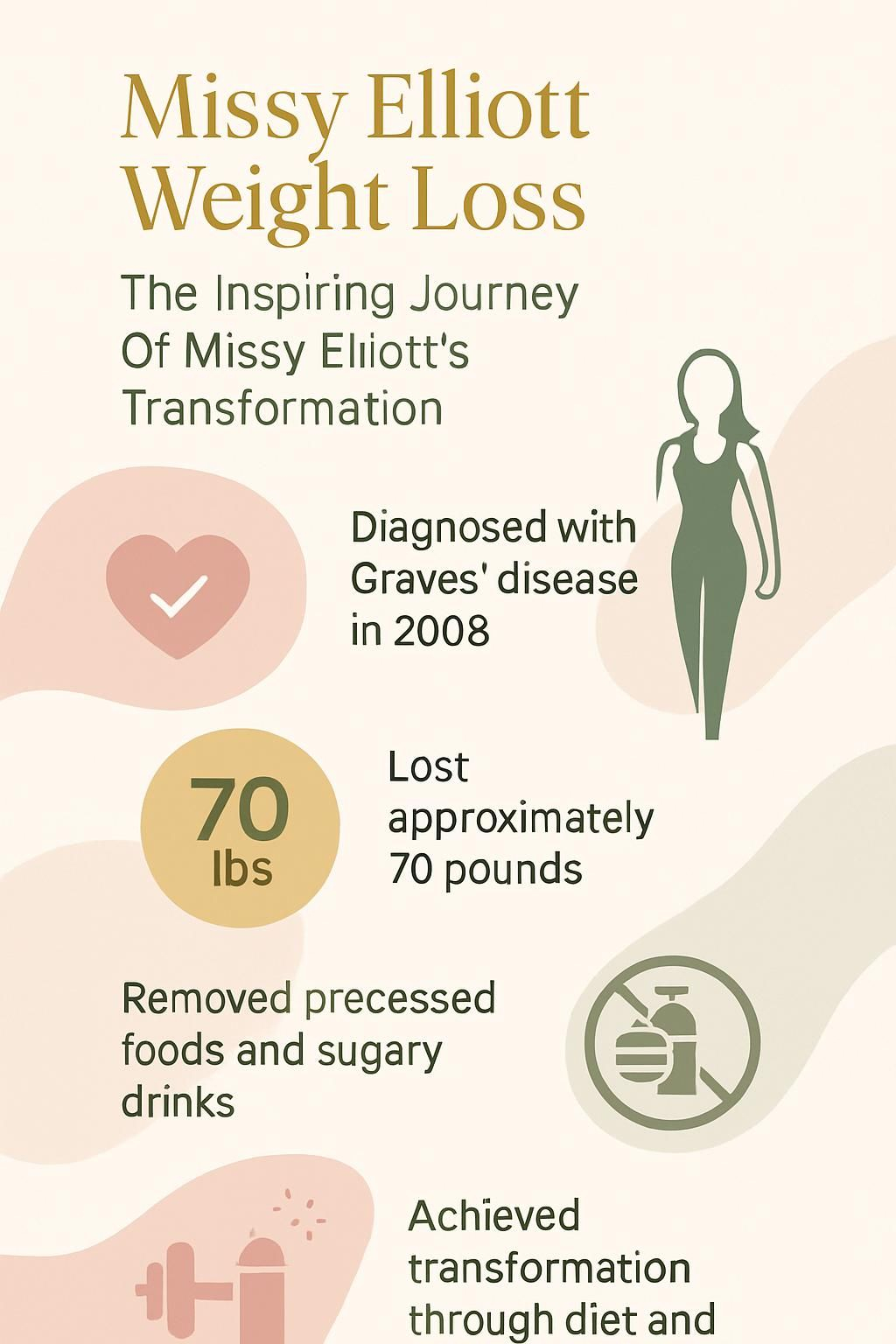Missy Elliott Weight Loss: The Inspiring Journey Of Missy Elliot’s Transformation
Our Nutrition Assistant AI Suite will transform your body. You will lose fat, get toned, and build muscle. Gain confidence and optimal health.
If you are trying to stay healthy while managing a medical condition, you are in good company. Missy Elliott’s weight loss drew attention after she faced Graves’ disease, an autoimmune disorder that affects the thyroid gland. Symptoms can include extreme fatigue, weight swings, and high blood pressure.
In this article, you will see what fueled Missy Elliott’s transformation, how she took charge with simple habits like better meals, cutting sugary drinks, and moving more, and why her story can guide your plan for wellness. You will also find practical steps you can use today.
Key Takeaways
- Missy Elliott was diagnosed with Graves’ disease in 2008. Symptoms such as fatigue and weight changes pushed her to pause her music career.
- Reports suggest she lost a significant amount of weight over several years by skipping sugary drinks, eating balanced meals, practicing portion control, and exercising often.
- No credible evidence supports weight loss surgery. She credits steady lifestyle changes for her results.
- Her plan removed processed foods and sodas, a smart choice for people managing thyroid symptoms like rapid heartbeat or weight shifts.
- Improved health supported a strong music comeback and inspired fans facing chronic conditions to build sustainable self-care routines.

Missy Elliott’s Health Journey

Life changed quickly for Missy Elliott after her Graves’ disease diagnosis. The condition affected her energy, mood, and weight. Her experience shows how a thyroid disorder can touch almost every part of daily life.
When was Missy Elliott diagnosed with Graves’ disease?
Doctors diagnosed Missy Elliott with Graves’ disease in 2008. Graves’ disease is an autoimmune disorder, which means the immune system attacks healthy tissue by mistake. In this case, it targets the thyroid, a small gland in your neck that controls metabolism and energy.
Missy described early signs like headaches, muscle weakness, and severe fatigue that began to interrupt her work and routines. These symptoms often show up before people realize the thyroid is involved.
“I was sick and I couldn’t even lift a pen,” she told People Magazine about her struggles after the diagnosis.
How did Graves’ disease affect her weight and health?
Graves’ disease can trigger fast weight changes, ongoing tiredness, and muscle weakness. Missy also faced severe headaches, mood shifts, and joint pain. These problems made both daily tasks and performing on stage much harder.
Because the thyroid controls metabolism, weight may rise or fall as hormones swing. Some people also develop thyrotoxic myopathy, which is muscle loss caused by too much thyroid hormone. Missy monitored her fitness during treatment, and she focused on simple nutrition shifts, like skipping soda and fruit juice and drinking water instead.
Why did she take time off for recovery?
As Missy’s symptoms grew, stepping back from music became necessary. Fatigue and muscle weakness can make regular training or touring impossible. Rest, medication, and careful monitoring helped her manage a rapid heartbeat, eye problems, and energy dips linked to Graves’ disease.
Many people with chronic illness face the same choice. Taking time off work helps the body heal, lowers stress, and supports consistent treatment.
What is Graves’ Disease?
Graves’ disease is an autoimmune condition that often targets the thyroid. The disorder can spark eye problems, weight changes, heat sensitivity, and anxiety.
What causes Graves’ disease?
With Graves’ disease, the immune system makes antibodies that overstimulate the thyroid. This leads to an overactive thyroid, also called hyperthyroidism, which speeds up metabolism and raises energy demand. Many people notice unexpected weight loss or increased appetite as a result.
Family history raises risk, and triggers can include stress, infection, or pregnancy. Women are affected more than men, especially between ages 30 and 50. If your family has autoimmune conditions like type 1 diabetes, your risk may be higher.
Knowing the cause makes it easier to understand the warning signs and plan care with your clinician.
What are the symptoms and challenges of Graves’ disease?
Graves’ disease affects both body and mind. Many symptoms can appear at once and change from week to week.
- Unexplained Weight Loss: Rapid or steady weight loss can occur even if you eat the same or more.
- Eye Problems, called Graves’ ophthalmopathy: Bulging eyes, redness, irritation, light sensitivity, or double vision may appear.
- Fatigue and Muscle Weakness: Daily tasks like climbing stairs or carrying groceries start to feel hard.
- Fast Heartbeat and Palpitations: A racing or irregular heartbeat can make rest or exercise uncomfortable.
- Increased Sweating and Heat Intolerance: Warm rooms feel intense, and cooling off becomes a priority.
- Tremors and Anxiety: Shaky hands, nervousness, mood swings, and trouble relaxing are common.
- Changes in Skin and Hair: Hair may thin, and skin can feel warm or look swollen around the shins.
- Persistent Hunger and Cravings: A faster metabolism can drive strong cravings for high-calorie foods.
- Sleep Troubles: Falling asleep and staying asleep can be difficult due to anxiety or discomfort.
I helped a friend manage routines after her Graves’ diagnosis, and I saw how symptoms disrupted work schedules and healthy habits like strength training, meal planning, and portion control.
How does Graves’ disease impact weight and energy?
Graves’ disease puts your body into overdrive. The thyroid releases too much hormone, which speeds up calorie burn. Weight can drop without any change in meals, and both fat and muscle may decrease.
Energy often crashes. People can feel jittery yet tired, and simple activities may be exhausting. Missy faced many of these shifts before her diagnosis. Treatment and steady habits helped her regain balance.
Missy Elliott’s Weight Loss Transformation
Missy Elliott’s transformation grew from quiet, consistent choices. Big change started with small steps.
How much weight did Missy Elliott lose and over what time?
Public reports vary on the amount of weight Missy lost, and the process took several years. Interviews link her early weight changes to Graves’ disease, which can cause large swings in both appetite and energy levels.
What stayed constant was her approach. She focused on daily decisions, not quick fixes. Cutting soft drinks and empty calories made a measurable difference. Over time, that consistency improved her health and stage performance.
What was her weight before and after the transformation?
Numbers shared in the media are estimates. They help show direction, not exact totals. Here is a simple view that reflects those public estimates and the context of her health journey.
| Stage | Estimated Weight (lbs) | Year/Period | Notes |
|---|---|---|---|
| Before Transformation | Approx. 210 | Pre-2008 | Diagnosed with Graves’ disease, faced fatigue and weight fluctuations |
| During Health Struggles | Varied (200–210+) | 2008–2014 | Symptoms and treatment influenced appetite, metabolism, and weight |
| After Transformation | Approx. 170 | 2018–Present | Maintained loss through steady habits, hydration, and regular activity |
- Some outlets cite a larger total change over many years, while others describe a 30 to 40 pound loss during a later phase.
- The exact amount matters less than her method, which centered on balanced meals, water, and movement.
- Consistency and patience were key drivers of progress.
- Cutting sugary drinks and processed snacks, and focusing on whole foods, helped the most.
- Her progress encouraged many people who face long-term health conditions.
From personal experience, significant weight change takes more than a meal plan. It requires mindset work, check-ins with your clinician, and realistic goals. Seeing a public figure stick with healthy routines can help you keep going on tough days.
How did she adopt a healthier lifestyle?
After her diagnosis, Missy treated health like a daily appointment. You can borrow the same approach.
- Choose a balanced plate with vegetables, lean proteins, and whole grains. Limit fried and highly processed foods.
- Use portion control at each meal to manage calorie intake.
- Skip sugary drinks like soda and fruit juice. Drink water to stay hydrated.
- Limit processed foods high in salt and preservatives to support blood pressure.
- Pick nutrient-rich snacks, such as fruit, nuts, or yogurt.
- Exercise most days with walking, dancing, or intervals for at least 30 minutes.
- Track meals and activity with a journal or app to spot patterns.
- Sleep 7 to 9 hours to recover and support appetite hormones.
- Set clear, realistic goals and celebrate small wins.
- Make self-care part of your routine, not a side project.
Missy’s Approach to Managing Her Health
Missy aligned nutrition, movement, and rest. That simple trio supported long-term change.
What role does a balanced diet and portion control play?
A balanced diet helps manage weight and supports thyroid health. Fruits, vegetables, lean protein, and whole grains provide vitamins and minerals your body needs. Portion control prevents extra calories that can stall progress or raise blood pressure.
For Missy, shrinking portions of sugary drinks and processed foods made healthier eating easier to stick with. Those small steps added up and improved how she felt day to day.
How does regular exercise fit into her routine?
Food choices set the base, and regular movement reinforces results. Missy used short, consistent workouts to support her goals while managing symptoms. Low-impact cardio, walking, and simple resistance work boosted energy without overwhelming her joints.
You can start small and build. I began with 15-minute walks, then added a few bodyweight moves. A steady routine helps more than intense plans you cannot maintain.
Why did she cut out sugary drinks and processed foods?
Sugary drinks and processed foods often pack excess sugar, unhealthy fats, and additives. Cutting them helps control weight and reduces blood sugar spikes. After her 2008 diagnosis, Missy swapped soda for water and focused on simple, whole foods. She reported better energy and fewer cravings as time went on.
These changes matter for thyroid health, since sodium and added sugars can make symptoms harder to manage. A cleaner plate supported her progress without shortcuts like surgery.
Did Missy Elliott Undergo Weight Loss Surgery?
Fans had questions, but her own words point to a different path.
Is there any truth to the weight loss surgery rumors?
No credible reports confirm weight loss surgery. Missy has consistently pointed to diet improvements, regular exercise, and skipping sugary drinks as the main drivers of her results.
Her journey highlights steady, natural methods rather than surgical procedures.
How did she commit to natural weight loss instead?
Missy chose food quality, portions, hydration, and movement. She cut processed foods and sodas, and she paired that with walking and cardio. Research supports these steps for weight management and heart health.1,2
If healthy choices feel hard, start with one swap. I cut soda for a month and noticed better energy and fewer snack cravings. Small changes, repeated daily, make a real difference.
How Did Motivation and Mindset Influence Missy Elliott?
Mindset is the engine that keeps small habits moving forward.
How did she stay motivated despite health challenges?
Missy set clear goals and celebrated small wins. Sharing progress on social media created accountability and support. Encouragement from friends and fans helped her stay consistent during rough patches.
A simple routine with balanced meals and regular activity gave structure. Music lifted her mood during flare-ups. Tracking tiny gains can boost confidence when progress feels slow.
How does she use her journey to inspire others?
She speaks openly about managing Graves’ disease and the power of daily choices. Updates about cutting sugary drinks and processed foods show that simple shifts lead to real progress.
Her story helps others believe change is possible. Focus on self-care, keep going through setbacks, and use support to stay on track.
Missy Elliott’s Career Comeback
Better health acted like a stage light, revealing the artist at full strength.
How did she return to the spotlight with renewed energy?
A stronger nutrition plan and regular exercise rebuilt stamina. These habits kept her energized during rehearsals and performances. Confidence grew with each set, and fans noticed.
Her mindset protected both her body and her art. Health and creativity moved together.
How does she balance her health and career?
Planning makes the balance work. She schedules meals, avoids sugary drinks, and keeps processed foods to a minimum when traveling. Short workouts fit between calls and studio time.
I have faced long workdays too. Protecting time for food and movement keeps energy steady and prevents backsliding.
Lessons from Missy Elliott’s Journey
Steady routines beat quick fixes. Start where you are and build from there.
Why is self-care and health management important?
Self-care lowers the risk of chronic disease and supports long-term wellbeing. Regular activity can cut the risk of type 2 diabetes by about 30 percent, according to the CDC.3 Nutritious meals give you energy, help stabilize weight, and support heart health.
Small routines stick better than big overhauls. Preparing simple meals at home and choosing water over soda can deliver quiet, steady wins.
How can long-term lifestyle changes be adapted?
Build change in manageable steps. Plan meals with whole grains, lean proteins, fruits, and vegetables. Set goals that fit your schedule.
Replace sugary drinks with water, and limit packaged foods. Track progress with a simple chart or an app. Choose activities you enjoy, like walking or dancing, and place them on your calendar. Ask friends or family for support. Use small, non-food rewards to keep motivation high.
Conclusion
Missy Elliott’s story shows the power of steady habits and self-care. With consistent choices in diet and exercise, you can move toward better health, even with a challenging diagnosis.
Use her example as a guide. Start with one meal, one walk, or one swap from soda to water. Progress builds when you repeat small wins.
Health information in this article is for education only and is not a substitute for professional medical advice. If you have symptoms of a thyroid disorder or concerns about weight changes, consult a qualified healthcare provider.Sources: American Thyroid Association on Graves’ disease and hyperthyroidism; National Institutes of Health on autoimmune thyroid disorders; Centers for Disease Control and Prevention on physical activity and chronic disease risk.
FAQs
1. What diet changes helped Missy Elliott achieve her weight loss transformation?
Missy Elliott focused on nutrition by reducing processed foods and sugar in her meals. She increased her intake of vegetables, lean proteins, and water to support healthy weight management.
2. Did Missy Elliott follow a specific nutrition plan during her journey?
Reports show she adopted a balanced approach to diet, emphasizing whole foods over restrictive eating patterns. This method provided essential nutrients while helping control calorie intake.
3. Are there any statistics about the impact of improved diet on weight loss like Missy Elliott’s?
Research from the Centers for Disease Control and Prevention states that people who eat more fruits, vegetables, and lean proteins are more likely to lose excess body fat than those who consume high-sugar or high-fat diets.
4. How can someone apply lessons from Missy Elliott’s experience with nutrition?
Choosing nutrient-rich foods instead of processed snacks can help manage body mass effectively. For example, swapping sugary drinks for water is an easy step toward better health outcomes.
Summary:
Missy Elliott’s inspiring transformation highlights how dietary choices play a key role in successful weight management. Evidence supports focusing on balanced nutrition as part of a sustainable lifestyle change.







